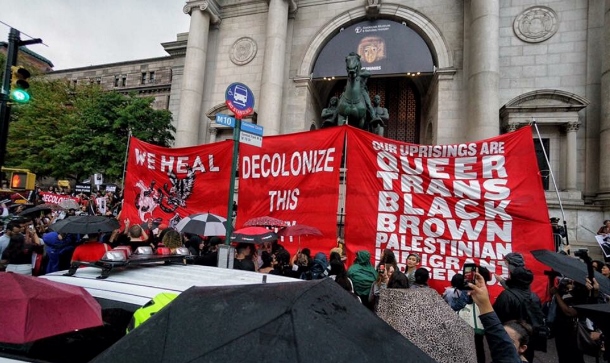
On October 9, the collective of political artists and organizers known as Decolonize This Place took over the American Museum of Natural History in New York City. This was in part a bid to pressure the city to rename Columbus Day as “Indigenous People Day,” but the action also zeroed in on how the museum’s exhibits preserve racist depictions of non-European peoples. Over the years several groups have demanded the museum confront and overcome this violent lineage, which is rooted in Western colonialism.
Over the course of weeks, these activists planned an action that would allow them to control the museum by hijacking its daily routine. Decolonize This Place joined with New York City Stands with Standing Rock, Black Youth Project 100, Eagle and Condor Community Center, South Asia Solidarity Initiative, the Chinatown Arts Brigade and many others organizations to offer a guided tour of the museum’s racism and colonial character. The ultimate goal was to showcase the retrograde side of the museum in hopes that it would inspire participants to imagine how the institution might be decolonized and redesigned.
The day of action began at 11 a.m. as activists prepared three, huge red banners emblazoned with images of indigenous peoples’ ongoing struggle against American settler colonialism. One of these depicted an eagle and condor, symbols of solidarity across the Americas, ripping apart a colonizing black serpent under the words “We Heal.” These were used to block the Theodore Roosevelt statue, regarded as a symbol of white supremacy, at the museum entrance.
After activists distributed free tickets to participants, the tour wound its way from the Roosevelt Rotunda through the culture halls of the Americas, Asia and Africa. Activists stationed at exhibits provided brief overviews of the stereotypes, inaccuracies and omissions upon which the museum relies for its descriptions of non-European peoples. The tour ended with a speak out in the rotunda that challenged Roosevelt’s writings on youth, manhood, nature and the state, which adorn the walls. Organizers charged the famed president as being implicated in seizing indigenous land, promoting a white heteronormative definition of youth, advocating genocidal statecraft, and being the “forefather of today’s fascists.”
Roosevelt’s ideological framework, defined by his belief in eugenics — or scientific racism — and racialized militarism, has been a sticking point for those demanding the museum remove his statue. Comparing non-Europeans to livestock, he once remarked that “society has no business to permit degenerates to reproduce their kind.” This sort of thinking is intimately tied in with the museum’s history, given that it hosted the International Eugenics Congress in 1921 and 1932. The calls for the statue’s removal and indictment of the museum are particularly poignant given the alt-right’s recent defense of Confederate monuments. Alt-right ideology often mirrors Roosevelt’s thinking on nature and race, especially considering the movement’s penchant for rebranding eugenics.
The museum’s adulation of a prominent white supremacist has drawn the ire of people of color for years. On February 21, 2015, the death anniversary of Malcolm X, the Black Youth Project 100 strung a banner across the base of Roosevelt’s statue that read “White Supremacy Kills.” Decolonize This Place began focusing on the monument last year while developing ties with the Eagle Condor Community Center and American Indian Community House. These New York based organizations advocate for and support indigenous communities. The statue, which is on land owned by the state, the museum and Manhattan island all fall within the territory of the Lenape people, who still struggle against settler colonialism and its impact today.
Maintaining the Roosevelt statue is only one example of how the museum commits itself to racist ideologies. In their letter to the public, Decolonize This Place observe that though Greek and Roman art is stored at the Metropolitan Museum of Art, the American Museum of Natural History lays claim to the works and culture of indigenous people.
Tlingit organizer and artist Jackson Polys notes a disturbing juxtaposition between non-European people and the museum’s primate exhibits. The exhibits dedicated to African peoples are similarly arranged in the museum just off of the Ackley Hall of African Mammals. The India section of the Stout Hall of Asian People boasts a plaque that is entitled “Indian Cycle of Life,” as if it were acceptable to frame the daily lives of 1.3 billion people as an expert might a study on fleas or protozoa.
What could the museum do to pursue a drastically different trajectory? Amrit Trewn of BYP 100, which is interested in building political relationships at the intersection of black and indigenous struggle, says that institutions like the American Museum of Natural History must strive to incorporate a “decolonial genealogy” into their exhibits that acknowledges their historic complicity in communal harm. Unlike institutions like the Denver Museum of Nature and Science and the San Diego Museum of Man, the American Museum of Natural History is far from implementing such measures.
The museum has announced an overhaul of its Northwest Coast Hall, which is slated for completion in 2020. The project’s website says that the “Museum’s curatorial and conservation staff will be consulting with several Pacific Northwest Coast communities.”
However, NYU Professor Jane Anderson argued that consultations will not provide a meaningful basis for collaboration. The museum “has no permanently employed curators from any of the indigenous communities represented in their exhibit culture halls,” she said. “Indigenous peoples who are represented in these halls, must be represented through their own terms and frameworks of meaning.”
Returning control of items taken from indigenous communities could represent the beginning of a dialogue acknowledging that territory has been seized. As Polys pointed out, “actual decolonization entails repatriation of land and territory.”
